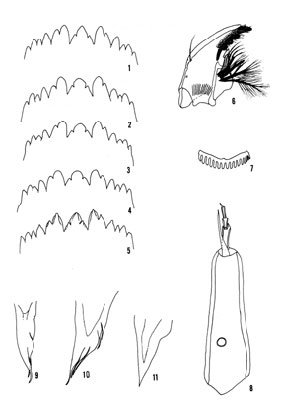C. cloacalis Martin

Fourth instar larva: a medium sized (9.6-18.0 mm; mean length female 14.7 mm; male 13.1 mm) plumosus-type; ventral tubules well developed, posterior pair longer (Ant. fem. 0.92-2.59; male 0.83-2.75 mm: Post. fem. 1.17-2.75; male 0.92-2.67 mm). Lateral tubules usually well developed, but occasionally shorter (120-480 µm).
Gular region generally darkened, frontoclypeus dark, but occasionally pale; also very occasionally with some darkening on other parts of the dorsal head capsule. Pale headed larvae are very difficult to distinguish from C. 'februarius', although the gula region should be more heavily darkened over the posterior half.
Mentum (Figs. 1-5) of type II or III, and c2 teeth generally notches on the c1 tooth, i.e. type IA or B, but may be more developed to type III.
Ventromental plates about 3.4 times wider than deep: separated by 0.27-0.31 of mentum width; with about 33-35 striae. Pecten epipharyngis (Fig. 7) with about 16 (12-21) teeth of type B.
Basal segment of antenna (Fig. 8) relatively long and narrow, about 4-5 times longer than wide; RO from a quqrter to a half up from base of segment; AR about 2.3-3.0; A2/A1 about 0.18; A2 (23-32 µm) less than width of A1 (30-38 µm); A4/A3 about 0.9-1.2; antennal proportions (µm) 147 : 28: 11 : 13 : 6.
Distance between S4 setae about 0.8 of Frontoclpeal width and equal or greater than the distance between the antennal bases.
Mandible of type IIB-IIIC, with about 12-15 furrows on the outer surface near the base; Pecten mandibularis with 12.4 (10-14) taeniae.
Illustrations of parts of the larval head capsule
and the pupal spur of C. cloacalis.From Martin (1971a). C. cloacalis appears to have a lower number of ventromental striae than C. 'februarius'. Cytology: 4 polytene chromosomes with the pseudothummi arm combination AE, BF, CD, G. All chromosomes generally closely paired.
Arm G with an almost terminal nucleolus, with 2 Balbiani rings; two of the known BRs are not developed, BR1 proximal to the median BR, and BR4 virtually at telomere. No nucleoli in long chromosomes. Low level of polymorphism in arms A, B, C, D, F, and G. The MD is on arm G (Martin & Lee 1984). cloA1: 1a - 2c, 10a - 12c, 3i - 2d, 9e - 4a, 13a - 19 as holomelas, etc.
cloA2: approx 1a - 2c, 11a-e, (6?)7 - 9, 2d - 3, 12a-c, (6?)5 - 4, 13 - 19
cloA3: 1a-e, 13e-a, 4 - 9, 2d - 3, 12 - 10, 2c-a, 13f - 19
cloB1: Puff and distal dark bands (groups 7-8) about 1/3 from centromere.
cloB2: Inversion of distal 2/3 of arm, proximal break in or just distal to puff, distal break near end of arm.
cloB3: Small inversion at distal end of the arm. Distal break closer to end than in B2.
cloC1: 1, 14 - 11d, 6b - 2, 15, 8 - 11c, 6gh, 17a - 16, 7d-a, 6fc, 17b - 22 (Wülker)
cloC2: abt 1, 14 - 11d, 6b-4, 6hg, 11c - 8, 15, 2 - 3, 17a - 16, 7d-a, 6fc, 17b - 22
cloC3: abt 1a, 5e - 6b, 11d - 14, 1i-b, 5d - 2, 15, 8 - 11c, 6gh, 17a - 16, 7d-a, 6fc, 17b - 22 (from cloC1)
cloD1: 1 - 2, 17 - 12b, 10 - 7, 3g-a, 6 - 4, 12a - 11, 18 - 24, (as febD1) (Kiknadze)
cloD2: 1 - 2, 17 - 12, 4 - 6, 3a-g, 7 - 11, 18 - 24 i.e the phylogenetically older sequence
cloE1: 1a - 2b, 5a - 10b, 3e - 2c, 4h - 3f, 10c - 13
cloF1: 1a - 2a, 4a - 10d, 3f - 2b, 11a - 23
cloF2: Pupa: General coloration is dark on the cephalothorax and abdomen. Some characters given in Table below.
Pupae from Queensland are smaller (abt. 9.37 mm, females; 8.66 mm, males) than those from Victoria (abt. 10.81 mm., females; 9.66 mm., males).
Frontal tubercles are short and conical. Base of respiratory organ 155 x 75 µm. Anterior to this base is a small elevated patch of wartlike tubercles; dorsal to the base is a larger, more elongated patch of smaller tubercles.
Shagreen pattern and chaetootaxy as in Fig. 12 (above).
Caudo-lateral spur on segment VIII (Figs. 9-11, above) normally with 3 or 4 spines, range 1 - 6. | | | Female | | Males | | | Mean | Range | Mean | Range | | Length (mm) | 9.8 | 7.6-10.8 | 9.2 | 7.6Ð10.4 | | Inner margin wing case (mm) | 2.0 | 1.4-2.2 | 1.9 | 1.7-2.1 | | Cephalic tubercles (µm) | | short | | larger | | Cephalic setae (µm) | 39 | 32-42 | 43 | 38-45 | | Recurved hooks on abd. seg. 2 | 95 | 81-108 | 74 | 70-106 | | Swim fin taeniae (one side) | 131 | 72-173 | 116 | 98-154 | Some data on the mentum given by Atchley and Martin (1971). Larval morphology and polytene chromosomes described by Martin (1971a). Sequences of arms A, E and F given by Wülker et al. (1989). Nucleoli and location of C-bands studied by Lentzios & Stocker (1979) and Lentzios et al. (1980). See also C. cloacalis adult; C. 'februarius' immatures.[ Return to Index | Go to References ] |
